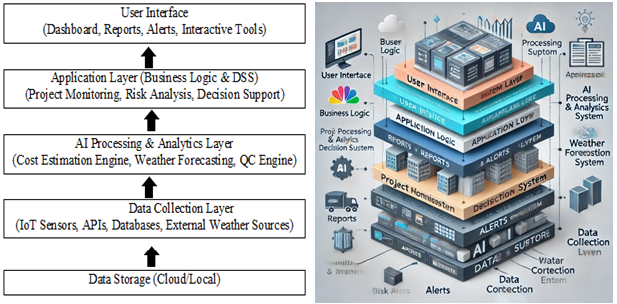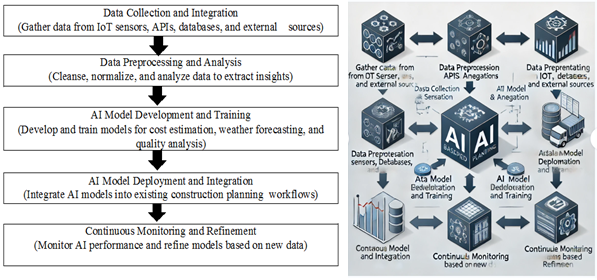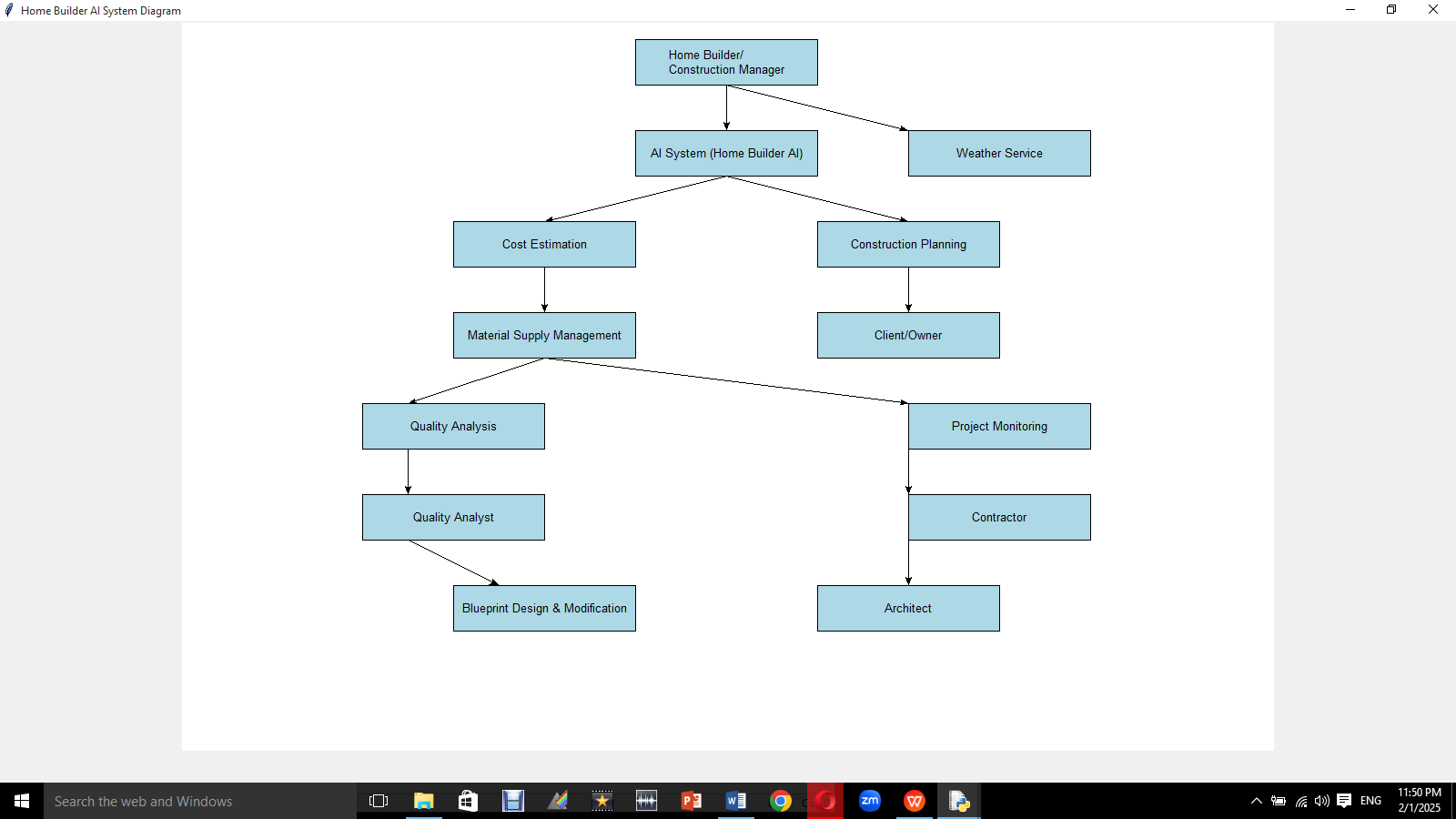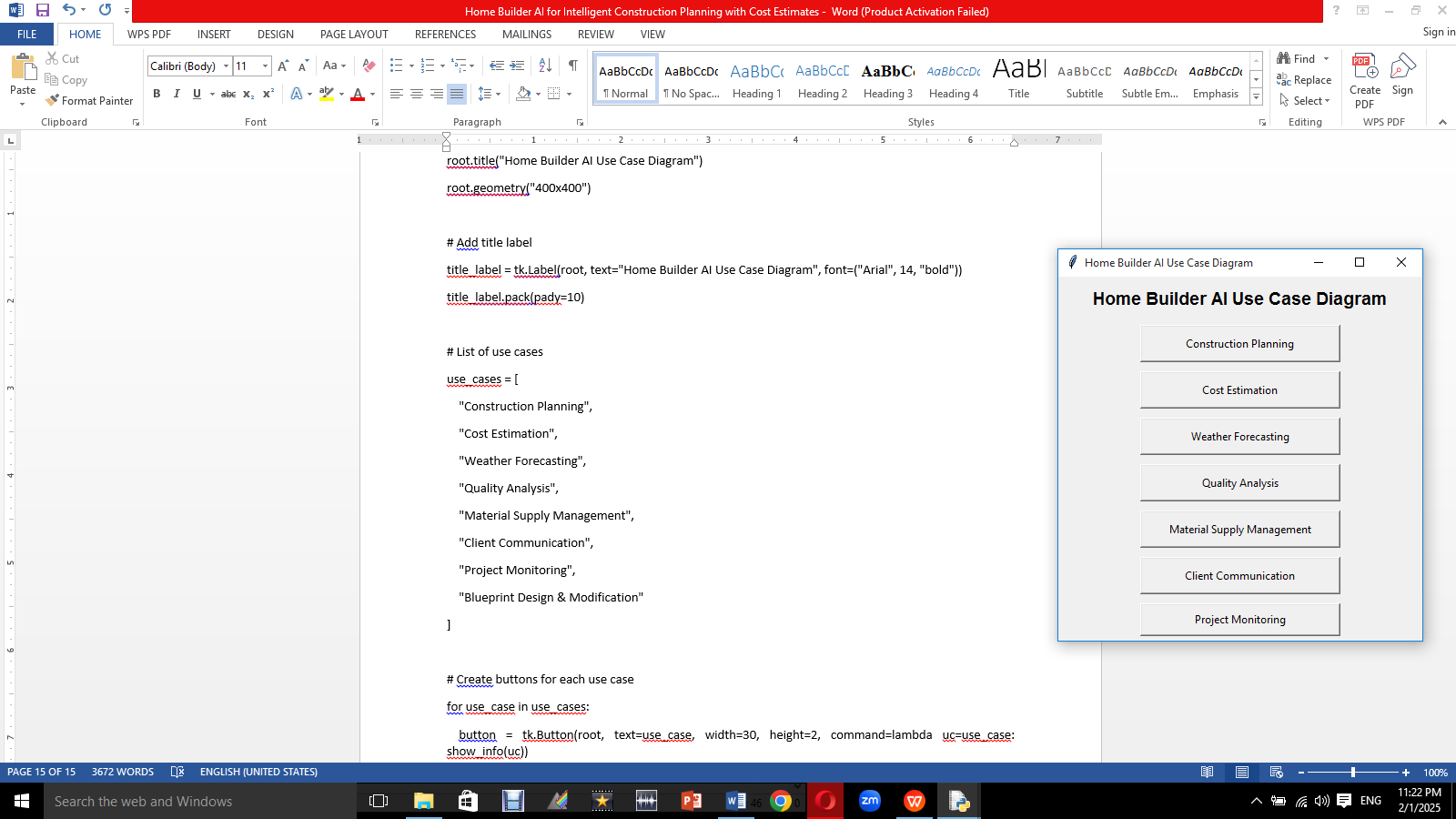Ijraset Journal For Research in Applied Science and Engineering Technology
- Home / Ijraset
- On This Page
- Abstract
- Introduction
- Conclusion
- References
- Copyright
Home Builder AI for Intelligent Construction Planning with Cost Estimates, Weather Forecasting and Quality Analysis
Authors: Mutha Venu
DOI Link: https://doi.org/10.22214/ijraset.2025.66822
Certificate: View Certificate
Abstract
The construction industry faces challenges related to cost overruns, project delays, and quality management. Home Builder AI is an advanced, intelligent system designed to address these issues by integrating Artificial Intelligence (AI) into construction planning and management. This innovative platform offers three core functionalities: cost estimation, weather forecasting, and quality analysis. The cost estimation module leverages machine learning algorithms to predict material, labor, and equipment expenses accurately, reducing budget discrepancies and enhancing financial planning. The weather forecasting feature utilizes real-time meteorological data to anticipate adverse conditions, allowing construction schedules to adapt proactively, minimizing delays and resource wastage. Furthermore, the quality analysis component employs AI-driven tools for continuous monitoring, defect detection, and structural integrity assessment, ensuring compliance with safety standards and building codes. By combining these features, Home Builder AI optimizes project workflows, improves decision-making, and reduces operational risks. It supports architects, builders, and project managers in creating efficient, cost-effective, and sustainable construction projects. This intelligent system not only streamlines the construction process but also contributes to higher productivity, better resource management, and superior construction quality, marking a significant advancement in the future of smart construction technologies.
Introduction
I. INTRODUCTION
The construction industry is complex, requiring effective planning, resource management, and risk mitigation. Traditional methods often struggle with inaccurate cost estimates, weather-related delays, and quality control issues, causing budget overruns and project delays. To address these challenges, the integration of Artificial Intelligence (AI) offers transformative solutions. Home Builder AI is an intelligent system designed to enhance construction processes through advanced cost estimation, weather forecasting, and quality analysis tools. Leveraging machine learning and real-time data analytics, it optimizes decision-making from planning to project completion. The cost estimation feature improves budget accuracy by predicting material, labor, and operational costs. The weather forecasting module minimizes delays by analyzing meteorological data, while the quality analysis component ensures structural integrity through automated inspections and defect detection. By combining these features, Home Builder AI boosts efficiency, reduces costs, and improves construction quality, driving the industry toward smarter, more resilient practices.
II. LITERATURE REVIEW
The integration of Artificial Intelligence (AI) in the construction industry has gained significant importance in recent years due to its potential to enhance project planning, resource management, and quality control. This section reviews existing research on AI applications in cost estimation, weather forecasting, and quality analysis within the construction domain.
A. AI in Cost Estimation
Cost estimation is critical for the success of construction projects. Traditional methods rely heavily on manual calculations and historical data, often leading to errors and budget overruns. However, machine learning algorithms such as regression models, neural networks, and support vector machines have shown the ability to predict construction costs with greater accuracy These models utilize historical project data, material costs, and labor rates to improve budget forecasting precision.
B. AI in Weather Forecasting
Weather conditions significantly impact construction schedules. AI-powered weather forecasting systems that leverage big data analytics and real-time meteorological data provide more accurate predictions compared to traditional models. Techniques like time-series analysis and deep learning help in accurately forecasting weather changes, enabling proactive project scheduling
C. AI in Quality Analysis
Quality control in construction often depends on manual inspections, which are time-consuming and prone to human error. AI-based quality analysis tools, such as computer vision and image recognition technologies, can automatically detect defects in construction materials and structures. These technologies effectively identify cracks, material degradation, and structural weaknesses, ensuring compliance with safety standards. Despite these advancements, current AI applications often focus on specific aspects of construction management in isolation. Home Builder AI aims to bridge this gap by integrating cost estimation, weather forecasting, and quality analysis into a unified platform, thereby enhancing overall project efficiency and decision-making.
III. EXISTING SYSTEM
In the current construction industry landscape, project planning, cost estimation, weather forecasting, and quality analysis are managed through fragmented systems and traditional methodologies. These existing systems, though functional, have several limitations that affect the efficiency and accuracy of construction projects.
A. Cost Estimation Systems
Traditional cost estimation relies on manual methods, spreadsheets, and basic accounting software. Estimators use historical data, standard cost databases, and personal experience to predict project expenses. While software like Microsoft Excel, Primavera P6, and SAP ERP offer support, they lack advanced predictive capabilities. This results in time-consuming processes prone to human error, cost overruns, and inaccurate budgeting.
B. Weather Forecasting Tools
Construction projects often depend on publicly available weather forecasts from services like AccuWeather, The Weather Channel, or government meteorological departments. These forecasts provide general data but are not tailored to the specific needs of construction sites. They lack integration with project management tools, making it difficult to adjust schedules proactively based on changing weather conditions.
C. Quality Analysis Techniques
Quality control is predominantly conducted through manual inspections, site visits, and checklists. Tools like AutoCAD and Revit assist in design validation, but real-time defect detection and material quality analysis rely heavily on human expertise. This approach increases the risk of oversight, delays in identifying structural issues, and inconsistent quality assurance practices.
D. Lack of Integration
One of the significant drawbacks of existing systems is the absence of integration. Cost estimation, weather forecasting, and quality analysis are treated as separate entities, leading to data silos. Project managers must manually consolidate information from different platforms, resulting in inefficient workflows and delayed decision-making.
E. Limited Use of AI
Although some modern construction management software incorporates basic automation, the utilization of AI for predictive analysis, real-time monitoring, and intelligent decision-making is limited. Existing solutions do not fully leverage AI’s potential for data-driven insights, risk assessment, or process optimization.
IV. PROPOSED SYSTEM
The Home Builder AI system is designed to revolutionize construction project management by integrating cost estimation, weather forecasting, and quality analysis into a single, intelligent platform. This system leverages advanced Artificial Intelligence (AI), Machine Learning (ML), and Data Analytics to address the limitations of existing systems, providing real-time insights, predictive analysis, and automated decision-making support.
A. Intelligent Cost Estimation
The proposed system uses AI-driven algorithms to enhance cost estimation accuracy.
- Predictive Models: Machine learning techniques, such as regression analysis, neural networks, and decision trees, are employed to analyze historical project data, material costs, labor rates, and market trends.
- Dynamic Updates: The system automatically updates cost estimates based on real-time fluctuations in material prices, resource availability, and project scope changes.
- Budget Optimization: It provides recommendations for cost-saving strategies without compromising project quality.
B. Advanced Weather Forecasting
Weather conditions are critical for construction scheduling. The Home Builder AI incorporates:
- Real-Time Data Integration: Collects and analyzes data from multiple meteorological sources for accurate, site-specific forecasts.
- AI-Based Prediction Models: Utilizes time-series forecasting and deep learning models to predict weather patterns, such as rainfall, temperature fluctuations, and wind speed.
- Proactive Scheduling: The system generates alerts for adverse weather conditions, allowing project managers to adjust timelines and reduce delays.
C. Automated Quality Analysis
Ensuring construction quality is vital for project success and safety. The system offers:
- Computer Vision Technology: Uses image recognition and AI-driven defect detection to identify structural issues like cracks, material degradation, and alignment errors in real-time.
- Sensor Data Analysis: Integrates with IoT devices and sensors to monitor environmental factors affecting construction quality, such as humidity, temperature, and material stress levels.
- Compliance Monitoring: Ensures adherence to safety standards and construction codes, reducing the risk of structural failures.
D. Integrated Dashboard and Analytics
- Unified Interface: The Home Builder AI provides a centralized dashboard where project managers can view cost reports, weather updates, and quality assessments in real-time.
- Data Visualization: Interactive graphs, heat maps, and analytical reports help in quick decision-making.
- Customizable Alerts: Users receive automated alerts for budget overruns, weather disruptions, or quality issues.
E. Decision Support System (DSS)
The system acts as an intelligent advisor, offering data-driven recommendations for:
- Resource Allocation: Optimizes the distribution of labor and materials based on project needs and environmental conditions.
- Risk Assessment: Identifies potential risks related to cost, weather, and quality, and suggests mitigation strategies.
- Project Optimization: Continuously evaluates project performance and suggests improvements to enhance efficiency and reduce delays.
V. SYSTEM ARCHITECTURE
The Home Builder AI system is designed with a modular, scalable, and integrated architecture to ensure seamless performance across various construction project management tasks. The architecture comprises several layers that work together to handle data collection, processing, analysis, and visualization. The primary components include the Data Layer, AI Processing Layer, Application Layer, and User Interface Layer.
A. System Architecture Overview:
The architecture can be divided into the following key layers:
- Data Collection Layer
- AI Processing and Analytics Layer
- Application Layer (Business Logic)
- User Interface (UI) Layer
- Feedback and Optimization Module
B. Key Components of the Architecture
1) Data Collection Layer
This layer is responsible for gathering data from multiple sources, including:
- Project Management Tools: Data on schedules, resources, and costs.
- Weather APIs: Real-time weather information from trusted meteorological services.
- IoT Devices & Sensors: On-site data related to material quality, temperature, humidity, and structural integrity.
- Historical Databases: Past construction project data for training AI models.
The data is collected in real-time using APIs, IoT gateways, and cloud-based data streams.
2) AI Processing and Analytics Layer
This is the core of the Home Builder AI system, where data is processed and analyzed using advanced AI and machine learning techniques:
- Cost Estimation Engine: Utilizes predictive models (e.g., linear regression, time-series forecasting) to generate dynamic cost estimates.
- Weather Forecasting Module: Implements deep learning models like LSTM (Long Short-Term Memory) networks for accurate weather predictions.
- Quality Analysis Engine: Leverages computer vision algorithms for defect detection and AI-powered data analysis for quality control.
- Data Preprocessing Unit: Cleans, filters, and normalizes data to improve AI model accuracy.
3) Application Layer (Business Logic)
This layer handles the core business logic and integrates different modules to ensure smooth workflow:
- Decision Support System (DSS): Provides data-driven recommendations for resource allocation, risk assessment, and schedule optimization.
- Alerts and Notifications System: Generates real-time alerts for weather changes, cost overruns, and quality issues.
- Data Integration Framework: Facilitates the smooth flow of data between the AI layer, databases, and the UI layer.
4) User Interface (UI) Layer
This layer provides an intuitive interface for users to interact with the system:
- Dashboard: Displays project status, cost breakdowns, weather forecasts, and quality reports using dynamic visualizations like graphs and heat maps.
- Interactive Modules: Allows users to input project data, adjust parameters, and view AI-generated recommendations.
- Mobile and Web Access: Ensures accessibility across devices, including smartphones, tablets, and desktops.
5) Feedback and Optimization Module
To improve the system’s performance over time:
- Continuous Learning: The AI models are regularly updated using new project data, enhancing prediction accuracy.
- Feedback Loop: User feedback and real-time performance metrics help refine AI algorithms and system functionalities.
- Optimization Engine: Analyzes system performance, identifies inefficiencies, and recommends process improvements.
C. System Architecture Diagram (Conceptual)

D. Advantages of the Proposed Architecture:
- Scalable: Easily adaptable to handle large-scale construction projects.
- Modular: Each component can be upgraded independently without affecting the entire system.
- Real-Time Processing: Provides real-time insights for faster decision-making.
- AI-Driven: Enhances accuracy and efficiency through predictive analytics.
- User-Friendly: Simplifies complex data through interactive dashboards and reports.
VI. IMPLEMENTATION
Integrating Artificial Intelligence (AI) into construction planning can significantly enhance efficiency, accuracy, and decision-making. By leveraging AI technologies, construction projects can benefit from improved cost estimation, advanced weather forecasting, and robust quality analysis.
A. AI-Powered Cost Estimation
AI can analyze extensive datasets, including historical project data, material costs, labor rates, and market trends, to provide more accurate and timely cost estimates. This approach reduces human errors and biases, leading to more reliable budgeting and financial planning. For instance, AI-driven design can reduce construction costs by up to 20% and save 50% on material waste.
B. Advanced Weather Forecasting
AI-driven weather forecasting models can process vast amounts of climate data to predict weather conditions with greater speed and accuracy. For example, Google's AI division, DeepMind, has developed a new weather forecasting model named GenCast, which can predict weather conditions 15 days in advance with remarkable accuracy.
C. Quality Analysis and Risk Management
AI can enhance quality analysis by identifying patterns and anomalies in construction processes, leading to improved quality control and risk mitigation. Predictive analytics can forecast potential risks and delays, enabling project managers to make informed decisions and minimize disruptions. AI can estimate construction costs by analyzing a range of data from different sources, including project plans, specifications, contracts, invoices, bids, and market trends.
D. Implementation Steps
To effectively implement AI in construction planning, consider the following steps:
- Data Collection and Integration: Gather and integrate data from various sources, including project plans, specifications, contracts, invoices, bids, and market trends.
- Select Appropriate AI Tools: Choose AI-powered software solutions that align with your project's specific needs, such as cost estimation, weather forecasting, or quality analysis.
- Train AI Models: Utilize historical data to train AI models, enabling them to recognize patterns and make accurate predictions.
- Monitor and Refine: Continuously monitor AI performance and refine models to adapt to new data and evolving project requirements.
By integrating AI into construction planning, projects can achieve more accurate cost estimates, better weather preparedness, and enhanced quality control, leading to improved overall project outcomes.
Integrating Artificial Intelligence (AI) into construction planning involves several key components working together to enhance efficiency and accuracy. Below is a high-level algorithmic diagram illustrating the process

1) Data Collection and Integration
Collect data from various sources, including IoT sensors, APIs, databases, and external weather sources. This data serves as the foundation for AI model development.
2) Data Preprocessing and Analysis
Cleanse and normalize the collected data to ensure consistency and accuracy. Analyze the data to extract meaningful insights relevant to construction planning.
3) AI Model Development and Training
Develop AI models tailored for specific tasks such as cost estimation, weather forecasting, and quality analysis. Train these models using the preprocessed data to enable accurate predictions and analyses.
4) AI Model Deployment and Integration
Integrate the trained AI models into existing construction planning workflows. This integration allows for seamless utilization of AI capabilities within the planning process.
5) Continuous Monitoring and Refinement
Continuously monitor the performance of AI models and refine them based on new data and evolving project requirements. This iterative process ensures that AI models remain effective and relevant over time.
By following this algorithmic approach, construction projects can leverage AI to enhance planning processes, leading to improved efficiency, cost savings, and quality outcomes.
For a more detailed exploration of AI applications in construction planning, consider reviewing the following resources:
- AI for Construction Site Planning and Optimization
- AI in Construction Planning and Scheduling
- AI in Planning Large Construction Project Schedules
A Use Case diagram for "Home Builder AI for Intelligent Construction Planning with Cost Estimates, Weather Forecasting, and Quality Analysis" could look like this:
E. Actors
- Home Builder/Construction Manager
- AI System (Home Builder AI)
- Project Manager
- Supplier
- Client/Owner
- Weather Service
- Quality Analyst
- Contractor
- Architect
F. Use Cases
- Construction Planning
- Actors: Home Builder/Construction Manager, AI System
- Description: The Home Builder AI generates intelligent construction plans based on available data, such as project requirements, materials, and timelines.
- Cost Estimation
- Actors: Home Builder/Construction Manager, AI System
- Description: The AI provides cost estimates based on factors such as material costs, labor costs, and project scope.
- Weather Forecasting
- Actors: AI System, Weather Service
- Description: The AI system retrieves weather forecasts from the Weather Service and adjusts construction schedules based on adverse weather conditions (e.g., rain, extreme temperatures).
- Quality Analysis
- Actors: AI System, Quality Analyst
- Description: The AI system analyzes construction quality, monitors construction progress, and suggests improvements.
- Material Supply Management
- Actors: Supplier, AI System
- Description: The AI system forecasts material requirements and communicates with suppliers to ensure materials are delivered on time.
- Client Communication
- Actors: Client/Owner, AI System
- Description: The client can access project status, cost updates, and schedules via the AI system’s interface.
- Project Monitoring
- Actors: Project Manager, AI System
- Description: The project manager uses AI to monitor the overall progress of the construction project, track key metrics, and ensure timely completion.
- Blueprint Design & Modification
- Actors: Architect, AI System
- Description: The architect designs initial blueprints and works with the AI system to make modifications as needed.
- Construction Site Reporting
- Actors: Contractor, AI System
- Description: The contractor provides updates to the AI system about work progress, and AI suggests adjustments or improvements based on real-time data.
G. Use Cases Diagram Structure
- Home Builder/Construction Manager: Interacts with all the main use cases: Construction Planning, Cost Estimation, and Weather Forecasting.
- AI System: Central to all use cases, coordinating with all other actors and managing the intelligent processes.
- Supplier: Interacts with the AI System for material supply management.
- Project Manager: Monitors progress through the AI system.
- Client/Owner: Receives updates via AI-driven interfaces.
- Weather Service: Provides weather data for intelligent scheduling.
- Quality Analyst: Ensures that the quality analysis is conducted and reports are generated.
- Contractor: Provides updates and information to the AI for monitoring construction progress.
- Architect: Works with the AI for blueprint design and modifications.

H. Explanation
- Actors are represented with boxes.
- Use Cases are represented by ovals.
- Associations are represented by lines connecting actors to use cases.
- For example, the AI System is connected to the Cost Estimation, Material Supply Management, Construction Planning, Weather Forecasting, Quality Analysis, and Blueprint Design & Modification use cases.
- Weather Service, Quality Analyst, Supplier, Contractor, Project Manager, Client/Owner, and Architect interact with the AI System to carry out tasks or receive updates.

Conclusion
A. Conclusion The Home Builder AI for Intelligent Construction Planning with Cost Estimates, Weather Forecasting, and Quality Analysis system aims to revolutionize the construction industry by leveraging the power of artificial intelligence to make the planning and execution of construction projects more efficient, cost-effective, and resilient to external factors like weather conditions. Key features of this system include: • Construction Planning: Automated generation of construction plans based on available data and project requirements. • Cost Estimation: AI-driven tools that provide accurate and reliable cost estimates, factoring in material and labor costs. • Weather Forecasting: Integration with weather services to adjust schedules based on weather predictions, reducing delays caused by adverse weather. • Quality Analysis: Continuous monitoring of construction quality, helping to identify potential issues early and improving the overall standard of construction. • Material Supply Management: AI helps forecast material needs and communicates with suppliers to ensure timely delivery. • Client Communication: Allows clients to stay updated on project status and costs through a user-friendly interface. These features enhance decision-making, reduce risks, and optimize resources, making construction projects more predictable and efficient. B. Future Enhancements While the current system offers essential functionalities, there are several areas where further enhancements could significantly improve its capabilities and broaden its impact: 1) Integration with Smart Devices: o Future versions of the system could integrate with IoT (Internet of Things) devices used on construction sites (e.g., sensors, drones, wearables). This would allow real-time tracking of construction progress, safety monitoring, and environmental data collection for more accurate decision-making. 2) Advanced Predictive Analytics: o The AI could evolve to include machine learning models that predict construction delays, budget overruns, and other potential project risks based on historical data and real-time updates. These predictive capabilities would allow project managers to take preventive actions earlier. 3) Augmented Reality (AR) and Virtual Reality (VR) Integration: o AR and VR could be used to visualize the construction process and provide virtual walkthroughs of the building before construction begins. This would assist architects, contractors, and clients in better understanding the design and plan. 4) Sustainability Analysis: o Future enhancements could include sustainability features that assess the environmental impact of construction materials, energy usage, and waste management. The AI could suggest greener alternatives and more sustainable practices to reduce the project\'s carbon footprint. 5) Automated Resource Scheduling and Allocation: o Incorporating automated scheduling tools could help allocate human and material resources more efficiently, ensuring that the right resources are available at the right time, thus improving efficiency and minimizing delays. 6) Multi-Language Support: o To expand the system’s reach globally, the platform could support multiple languages, making it accessible to construction teams and clients worldwide. 7) Blockchain for Transparency and Security: o Using blockchain technology for tracking contracts, payments, and supply chain data could increase transparency and security within the construction project, ensuring that all stakeholders have access to reliable and immutable records. 8) Integration with Building Information Modeling (BIM): o Integrating AI with BIM would allow for more precise construction planning, coordination, and visualization, ensuring all stakeholders are aligned with the building’s design and construction processes. 9) Voice Command Features: o Adding voice command functionality for construction managers and workers could improve usability on construction sites, where hands-free operations are often needed. 10) Client and Stakeholder Dashboards: o More interactive dashboards for clients and stakeholders to visualize project progress, costs, timelines, and quality metrics, enabling better engagement and transparency throughout the project lifecycle.
References
REFERENCES [1] \"Artificial Intelligence in Construction\" • Authors: Korman, T., & Lavy, S. • Publisher: Springer (2020) • Summary: This book provides a comprehensive overview of AI applications in the construction industry, including project planning, design, cost estimation, scheduling, and risk management. [2] \"Cost Estimation and Management in Construction\" • Author: Venkatesh, A. • Publisher: Springer (2019) • Summary: A detailed guide to cost estimation in construction, covering traditional methods and AI-based techniques for more accurate cost forecasting and budget management. [3] \"Project Management for Construction: Fundamental Concepts for Owners, Engineers, Architects, and Builders\" • Author: Chris Hendrickson • Publisher: Prentice Hall (2008) • Summary: This book explores the fundamentals of project management for the construction industry, providing insight into scheduling, cost control, and risk management. [4] \"Building Information Modeling (BIM) in Design, Construction, and Operations\" • Author: Rien Mulder • Publisher: Springer (2019) • Summary: Focuses on the integration of BIM with other technologies, including AI, and how it improves the efficiency and accuracy of construction project management. [5] \"The Construction Project Management Success Guide\" • Author: Michael G. Cagle • Publisher: Wiley (2020) • Summary: This book offers practical advice and strategies for managing construction projects successfully, with a focus on budgeting, planning, and scheduling, using the latest technological tools like AI. [6] \"Internet of Things (IoT) for Smart Construction\" • Author: Ahmed M. A. El-Hai • Publisher: Elsevier (2020) • Summary: Explores the application of IoT technologies in the construction industry, covering topics such as real-time data collection, smart sensors, and AI integration to optimize construction processes. [7] \"Sustainable Construction: Green Building Design and Delivery\" • Author: Charles J. Kibert • Publisher: Wiley (2016) • Summary: A key resource for sustainable building practices, focusing on green construction, material selection, energy efficiency, and the integration of AI for environmental analysis. [8] \"The Lean Builder: A Builder’s Guide to Applying Lean Tools in the Field\" • Author: Joe Donarumo & Keyan Zandy • Publisher: Wiley (2020) • Summary: This book introduces the principles of lean construction, with practical applications on the job site, and how to leverage AI and other modern technologies to optimize construction workflows. [9] \"Machine Learning for Construction: Applications in Project Management and Engineering\" • Author: Zhongxian Wang, Yue Wu • Publisher: Springer (2021) • Summary: Focuses on how machine learning algorithms are being applied in construction project management, with case studies and examples of their practical use in scheduling, resource allocation, and cost estimation. [10] \"Quality Management in Construction Projects\" • Author: Timothy L. Williams • Publisher: Wiley (2018) • Summary: Provides insights into maintaining and improving quality in construction projects, covering topics like risk management, quality control systems, and AI-based quality analysis.
Copyright
Copyright © 2025 Mutha Venu. This is an open access article distributed under the Creative Commons Attribution License, which permits unrestricted use, distribution, and reproduction in any medium, provided the original work is properly cited.

Download Paper
Paper Id : IJRASET66822
Publish Date : 2025-02-04
ISSN : 2321-9653
Publisher Name : IJRASET
DOI Link : Click Here
 Submit Paper Online
Submit Paper Online

